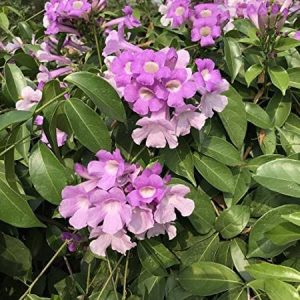BOTANICAL NAME: Manosa alliacea (Lam.) Miers, Mansoa alliacea (Lam.)
FAMILY: Bignoniaceae (Jacaranda family)
ENGLISH NAME: garlic vine, cross vine
COMMON NAME:
Sanskrit: Kutir vallari
Hindi: lashun bel
Bengali: Lata parul

HABITAT: Native to South America. All around India.
DESCRIPTION: It can either be described as a shrub or a vine since it produces numerous woody vines from the root that grow only 2-3 m tall and form a shrub-like appearance. It produces bright green leaves up to 15 cm long. Its compact habitat and pretty continuous flowers make it a popular ornamental plant in gardens in the tropics. Flowering twice a year you will find it quite often covered with flowers. Flowers start off purple with white throat and change to a lighter shade of lavender with age. Eventually fading to almost white. You will see 3 different color of flowers at the same time on the plant. It can be grown in containers and should be trimmed after the flowers are gone.
AYURVEDIC CHARACTERISTICS:
| RASA | GUNA | VEERYA | VIPAKA | PRABHAVA | DOSHGHNTA |
| Katu | Tikshna | Ushna | katu | drishtigata | Kaphvata nashak |
AYURVEDIC ENERGETICS:
| TASTE | PROPERTY | POTENCY | POST DIGESTIVE EFFECT | EFFECT ACTION | DOSHA ACTION |
| Pungent | Sharpness | Hot | Pungent | Improve vision | Pacifies kaphvata dosha |
MAJOR CHEMICAL CONSTITUENTS: Allyl methyl trisulphide, allylpropyl disulphide,
THERAPEUTIC USES:
- SKIN DISEASES– Paste of leaves used in skin diseases.
- INFLAMMATION– Leaves tied over affected area of inflammation.
INDICATIONS:
Kusth Leprosy, Sotha Inflammation, Netra vikara Eye diseases.
USEFUL PART: bark, root
DOSAGE: 50gm
AYURVEDIC FORMULATION:
Lahsunadi vati
